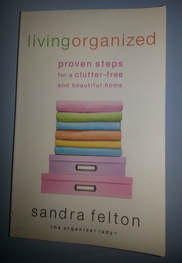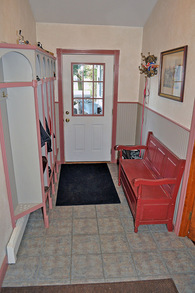
I often come across organizing books on clients’ bookshelves that were purchased in an attempt to get organized. Many clients give a little laugh, “Well, I guess that didn’t work” and hand me the book thinking I might gain better use than they did. This does happen - I sometimes adapt ideas for other clients, pass the book along or grab personal insights to improve my own home. One such book I recently came across was Living Organized by Sandra Felton. (Living Organized: Proven Steps for a Clutter-Free and Beautiful Home, by Sandra Felton, 2004, Fleming H. Revell, Grand Rapids, MI.) It is a typical organizing book in that it describes personalities, strategies, maintenance and the psychology clutter. As an organizer, these books as a whole rarely offer anything new that I have not seen or heard before. However, there were two outstanding sections I found helpful both personally and professionally. Below is an overview of the book with my favorite sections noted.
Living Organized is set up in six parts. Throughout there are stories, quizzes and letters from real situations. In the first few parts, many detailed descriptions help the reader understand the Messie concept, confirm their own personality type, and find hope for change if they are a Messie (or living with one.) A Messie is a right brain dominant, creative person who oftentimes struggles with clutter. There are good descriptions of Messies and Cleanies; right brain versus left brain dominant personalities; history of housework; and the response of family members to a Messie and his/her clutter. Also here is the first outstanding section of the book: the phenomenon that right-brained, creative people are most comfortable keeping their childhoods alive via memories and mementos. Childhood pictures and memorabilia are not just parts of the past but are real, living treasures of the present for Messies. These physical things are kept to remind the owner of his/her creative, impulsive, idealistic, fun-loving nature. These personal characteristics are integral to a Messie's nature and so are the belongings. Efficient management and storage of these things become extremely important. Subsequent chapters describe such space saving ways to organize.
Part four attempts to teach how to declutter a home. There is the briefest instruction on how to clear clutter. I doubt most Messies could even get started by reading this book. At one point the author says, “Let us assume that your house has come under a moderate degree of organizational control.” I wondered, how did that happen without more step-by-step guidance? More importantly, the motivational piece for decluttering is also in short supply. Perhaps the author’s pioneering Messies Anonymous support groups fill that purpose.
On a positive note, (if you get your house clutter free) the cleaning chapter is a bit more useful. It describes three levels of cleaning: big stuff, little stuff and congealed stuff and how to tackle each type. There are motivational notes for Messies to make their cleaning faster and easier.
Another chapter gives general organizing hints. It reminds the reader that he/she must make decluttering an everyday activity not just an occasional one. There are standard solutions for problem areas common to every home. The author teaches basic organizing principles such as defining the uses for each room, locating like things together, eliminating duplicate tools and storing supplies close to where they are used.
The last parts of the book describe home design and decorating. These make up the second outstanding area. I found inspiration in the author’s guidance to come to terms with the energy of your home. She describes the haphazard way many homes are put together, without much thought to consistency or appearance. Making a home cohesive and attractive is possible even if the occupants have very little design ability. Moreover, the author does a great job helping the reader find his/her personal style and how to begin to apply it to the home. She describes little actions (and includes a question/answer section) that eventually, over time improve the feel of a home.
An interior designer has written the section on decorating and design. This is a hands-on, entertaining set of instructions based on the MAGIC ROOM method. It teaches how to find your personal style and how to achieve it in a methodical fashion. The result, they say, is a room that you deserve. It includes decorating scenarios as examples of faulty decorating. It describes step-by-step tasks to identify your preferred colors, textures, ideas and objects. If anything were to work for me, this would be the system. I can imagine following it and getting a home that reflected my personality perfectly. The designer further points out that individualized decorating improves mood and physical well-being. I was so happy to see that this section also cautions the reader to be practical in choosing colors and fabrics: nothing that will get dirty fast, ruined quickly or be hard to maintain.
The value of Living Organized for me consisted of the outstanding features above. Other readers may likely find different reasons to value the book. Overall I found it motivational and worth the time.


 RSS Feed
RSS Feed
